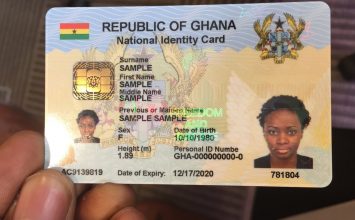Whereas in Nigeria, the National Identity Management Commission (NIMC) is still wobbling just to give Nigerians mere National Identity Number (NIN) for more than four years now, its counterpart in Ghana, the National Identification Authority (NIA) is seamlessly giving out complete national ID card popularly called Ghana Card with NIN inclusive.
By the Government of Ghana timetable, the mass registration for the Ghana Card started nationwide from the Greater Accra Region on April 29, 2018, and expected to end by March, 2020.
Business Hilights Ghana Bureau chief report that NIA has registered 8,733,440 eligible Ghanaians for the Ghana Card as at Tuesday, February 11, 2020, with 7,436,522 cards printed and 5,332,620 issued to applicants.
Additional details also showed that the Ghanaian agency has, so far, registered 2,467,617 in the Ashanti Region, 1,995,669 in the Greater Accra, Volta – 568,265, Central – 625,803, Northern – 510,047 and Western – 530,684.
The rest of the regions are; Oti – 360,296, Bono – 294,440, Bono East – 277,485, Upper East – 220,191, North East – 197,057, Western North – 217,719, Savannah – 178,009, Upper West – 146,976, Ahafo – 141,191.
In an interview, the Head of the Corporate Affairs Unit of the NIA, Mr Francis Palmdeti, explained in Accra weekend that it was currently registering people in the Western, Western North and Central regions.
According to him, the Eastern Region would be the next stop for the mass registration in March, which would be the last region to be registered.
Giving a breakdown of the occupational registration statistics, Mr Palmdeti said 1,550,984 farmers had been registered, students – 1,363,104, retail market traders – 827,084, unemployed – 473,174, and teachers – 379,237.
The rest are business men/women – 334,841, artisans including tailors, dressmakers, sewers, upholsterers and related workers – 280,708 and hairdressers, barbers, beauticians and related workers constituted 213,490, retirees – 185,758, while bricklayers, carpenters and other construction workers made up 125,266.
The official further averred that NIA would use the first two weeks in April to do the mop-up exercise across the country and afterwards set up cognate offices to enable those who could not register during the mass registration exercise to do so.
Giving insights on the observed slow pace of the registration process, Mr Palmdeti said sometimes the network slowed down the registration process while inconsistency with an applicant’s biometric data could also delay the issuance of the ID card.
According to him, “Under normal circumstances, it took a maximum of 30 minutes to complete the registration of an applicant, adding that every registration centre was supposed to have three registration machines with each capable to register at least 30 applicants a day.”
“For instance, if your finger prints match the machines by 50 per cent or you have changed your date of birth but you haven’t gone through the legal processes or not gazette your name after changing it, you may have a problem getting your ID card,” Mr Palmdeti said.









